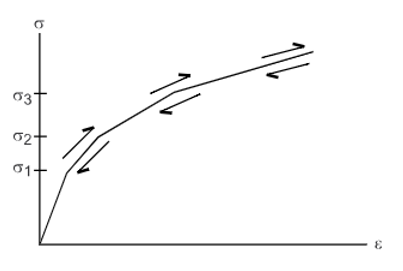The multilinear elasticity material model causes unloading to occur along the same path as loading. This behavior is conservative (path-independent). The plastic strain should be interpreted as a pseudo-plastic strain, as it returns to zero when the material is unloaded.
Multilinear material behavior is described by a piece-wise linear stress-strain curve,
starting at the origin, with positive stress and strain values. The curve is continuous from
the origin through a set of designated stress-strain points. Successive slopes can be
greater than the preceding slope; however, no slope can be greater than the elastic modulus
of the material. The slope of the first curve segment usually corresponds to the elastic
modulus of the material, although the elastic modulus can be input as greater than the first
slope to ensure that all slopes are the elastic modulus.
Define the elastic behavior via MP or TB,ELASTIC. Define a material data table for the stress-strain values via TB,MELAS, and specify the values via TBPT.
| TBPT Values for Stress-Strain | ||
|---|---|---|
| Constant | Units | Property |
| X | Dimensionless | Strain value |
| Y | Force/Area | Corresponding stress value |
Example 4.41: Defining Stress-Strain Values for Elastic Behavior
TB, ELASTIC,1,2 TBFIELD, TEMP,70 TBDATA, ,1E4,0.3 TBFIELD, TEMP,200 TBDATA, , 1E3,0.3 TB, MELAS,1,2,3 TBFIELD, TEMP, 70 TBPT, ,0.00005,0.5 TBPT, ,0.00105,0.8 TBPT, ,0.00305,1.1 TBFIELD, TEMP, 200 TBPT, ,0.0010,1.0 TBPT, ,0.0020,1.2 TBPT, ,0.0040,1.4
The program uses the total strain components εn to calculate an equivalent total strain measure:
which is used with the input stress-strain curve to get an equivalent value of stress σe.
The elastic (linear) component of strain can then be calculated:
and the nonlinear portion is:
To avoid an unsymmetric matrix, only the symmetric portion of the tangent stress-strain matrix is used:
which is the secant stress-strain matrix.
Also see Material Model Support for Elements for this material model.
For postprocessing, specific solution output is available for multilinear elasticity (TB,MELAS). Nonlinear strains are output as EPPL. The value of equivalent total strain (used to calculate the equivalent stress) is available as part of the nonlinear solution record NL and can be processed as the EPEQ component of NL.



